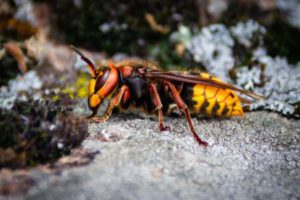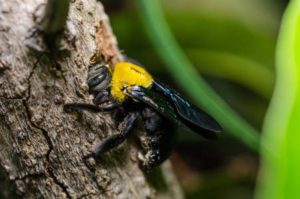IT’S A CARPENTER BEE, NOT AN ASIAN GIANT HORNET!
By Zachary Ciras on May 7, 2020.
When we were out on our deck yesterday, a really large black and yellow hornet kept buzzing and threatening us. We only saw one though. Could this be one of those Giant Murder Hornets from Asia that were just found in the U.S.?
J.B., Wellesley, MA
THE GIANT MURDER HORNET MURDERS BEES

Shutterstock
There’s no chance that you were harassed by an Asian giant hornet, for several reasons: (1) The hornet is from Japan and so far has only been detected in the U.S. in Washington state. (2) The Asian giant hornet is dull orange and rusty brown with a striped abdomen and a noticeable, large yellow-orange head. (3) This hornet is almost 2 inches long; while we have some large hornets, this hornet is indeed “giant.” The Asian giant hornet is called the “Murder” hornet because it attacks and decapitates honeybees, a real concern for beekeepers and the nation’s crops.
CARPENTER BEES ARE NEST BUILDING NOW
The hornet that was threatening you is almost certainly not a hornet (wasp) at all, but given the time of year and the situation, was probably a carpenter bee. A deck, especially one that is weathered or untreated is a typical place to find a pair of carpenter bees constructing a nest. The nest does not look like a typical bee or wasp nest since carpenter bees hollow out a nest gallery inside wood. You may never even know a nest is there in a deck railing or piece of redwood furniture unless you see the dime-size opening.

Shutterstock
Carpenter bees are very large, robust bees, but not nearly as large as the giant hornet. With a fuzzy yellow thorax and shiny black abdomen, they’re often confused with bumble bees. Bumble bees, however, have a hairy, not shiny abdomen and live in a colony with other bees. Carpenter bees, like all bees, are beneficial pollinators. They occur singly, or in pairs, and not in colonies.
It was probably the male carpenter bee that was threatening you in his attempt to protect his mate while she hollows out the nearby nest, lays eggs in larval cells, and provisions them with pollen. The good news is that the male doesn’t have a stinger, he’s all bluff. The female can sting but is not easily provoked (see Carpenter Bee Visits Are Brief and Stings Are Rare).
CARPENTER BEES ARE USUALLY A SHORT-TERM NUISANCE
The other good news is that the whole nest-building process is completed in a matter of days. Once the nest is sealed off, the pair moves on and you may not see carpenter bees again for the rest of the summer.
The bad news, however, is that the bees that emerge from the nest tend to nest in the same general area next year, and often pairs of carpenter bees will nest together when they find desirable wood conditions (see Yes, Carpenter Bees Can Nest Again in Your Deck). Repeated nesting by several pairs of bees can result in wood damage. And sometimes, woodpeckers can make the damage much worse when they attempt to reach bee larvae in the wood.
Carpenter bees attack softwoods (teak, cedar, redwood, pine, fir), especially wood that is weathered and unfinished. Bee nesting and resulting damage can occur on decks and deck furniture, along the roofline on the unpainted backside of fascia boards, soffits, unpainted trim boards, barn siding, cedar posts, mailbox posts, and weathered windowsills, to name a few.
For more on carpenter bees, see What Are Those Big Black Bees?
CALL COLONIAL PEST, WE CAN HELP
There are steps you can take to deter carpenter bee nesting in the future (ask us), and there are steps that we, at Colonial, can take to block or eliminate carpenter bee or woodpecker damage in the short term.
If you’re concerned about having pest control technicians at your home at this time, know that we will be employing no-contact measures and following recommended safety procedures (see Colonial Pest Control’s COVID-19 Response). Give us a call!